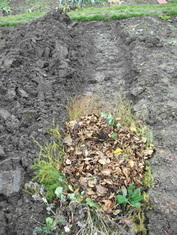At this time of year even the most capacious compost heaps can become overfull. Take the time to plan ahead and you can keep things neat and save yourself work.
First, get the compost heap rotting down as fast as possible. You've already put all the early summer peas and beans on it, plus stuff from your back garden. When weeding, don't shake all the soil off the weed roots - valuable bacteria are in there and by putting a little soil in the heap you 'inocculate' it with a starter culture of everything you need for good composting. Feed those bacteria with some nitrates; you can use fresh manure, pelleted chicken manure, proprietary compost activator or even human wee (a traditional starter substance) if the fancy takes you.
Too much manure can make your compost heap acidic and slow the composting process. If using actual manure, alternate applications of manure with sprinklings of garden lime. a layer of vegetable matter, some manure, another layer of vegetable matter, some lime . . .

Dig a trench across the patch you intend to use, making it roughly 2-3ft (60cm-1m) wide. Go down until you reach subsoil - you'll recognise this because it is denser, and usually lighter in colour. Using a fork, roughen up the subsoil bottom very slightly - no need to break your back. The soil you've taken out of this hole will look like a lot more than what you would expect to fit; pile it on one side or on either side of the hole.
Fill your trench with any organic matter you can get your hands on - spud peelings, grass clippings, dead-headings from the garden, fresh manure picked up by the bag. (See below - "Foraging for organic matter"). The only things you shouldn't put in are:
- Woody prunings
- Weeds or plants with persistent roots, such as dandelions or mint.
- Wood shavings - sometimes bagged manure has a lot of wood shavings in.
For more composting tips, click here
 RSS Feed
RSS Feed
